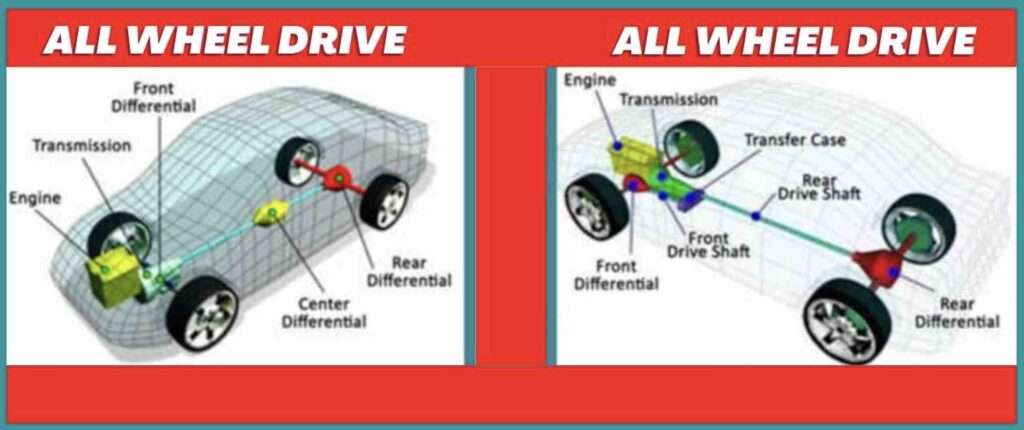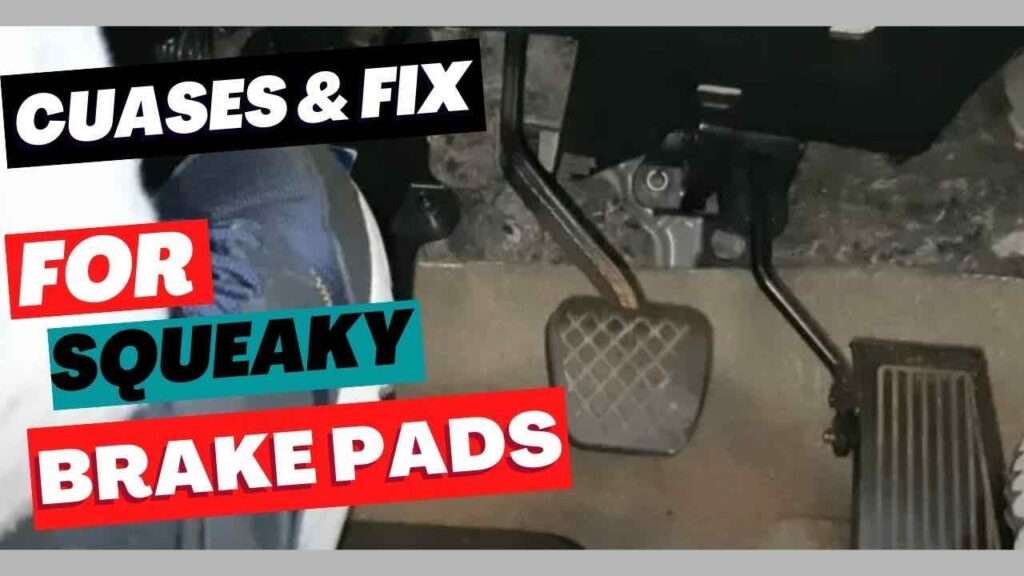Last updated on December 8th, 2022 at 01:43 pm
When purchasing a new automobile, there are various factors to consider; finding the perfect drivetrain for locating new roads is one of the most crucial things you can do. Each has benefits and drawbacks, and it’s critical to grasp them all before making the best selection for you. All-wheel-drive (AWD), front-wheel-drive (FWD), and four-wheel-drive (AWD) are the four different types of powertrains (4-wheel drive).
Here are some of the sub-area we will discuss in this article.
- What is AWD meaning? And 4WD means in cars
- What is the FWD meaning and 4WD, AWD vs FWD pros and cons?
- Overview of FWD vs. AWD in snow and Between AWD or 4WD, Which is better?
- What is the significant difference between all-wheel drive (AWD) and four-wheel drive (4WD)?

What is AWD meaning?
All-wheel drive is a drivetrain that sends power to all four wheels of a vehicle via a front, rear, and center differential. As the name implies, all-wheel-drive systems provide constant power to both the front and rear wheels. In practice, however, AWD refers to two different types of drivetrains. Full-time AWD refers to the fact that all four wheels are driven continuously.
The second, sometimes known as part-time AWD or automatic AWD, functions in the two-wheel-drive mode most of the time, with the power given to all four wheels only when more traction control is required. Whatever driveline you choose, remember that having a decent set of snow tires is essential in the winter.
4WD means in cars
When 4X4 is engaged, the power from the engine is delivered to all four wheels at all times. It also can function in an RWD format to save gasoline. A 4WD vehicle’s most significant advantage is its adaptability and power, which allows it to tackle any terrain or weather condition. The disadvantage of a 4WD car is that it usually operates in RWD mode and has less traction than an AWD vehicle.
What does FWD mean on a car?
The power from the engine is sent to the front wheels of your car, which is referred to as FWD. The front wheels pull the automobile in FWD, whereas the back wheels receive no power on their own. The advantages of a front-wheel-drive vehicle are that they often have higher fuel economy and generate less CO2.
Meaning of FWD, 4WD, & AWD with Their Pros and Cons
An FWD car can maintain superior grip in the snow since the engine’s weight is distributed over the driving wheels. On the other hand, performance fans argue that FWD vehicles are less enjoyable to drive.
What are 4WD, AWD vs. FWD pros and cons?
All automobiles have four wheels. They receive power from the engine, which allows the automobile to drive forward or backward. That simple fact is valid for all automobiles. However, each car’s transmission and driving wheels are not always powered similarly.
Front-wheel drive (FWD), rear-wheel drive (RWD), four-wheel drive (4WD), and all-wheel drive (AWD) are the four main drive types on cars (AWD). Each has its own set of uses and functions, and we’ll look at each separately to discover how they work.
1. Four-Wheel Drive (4WD)
Using a transfer box on the car’s underside is known as 4WD or four-by-four. As the name implies, the transfer box distributes power evenly between the front and rear wheels.
Most 4WD cars have a stick or switch in the driver’s console to switch between two-wheel drive and four-wheel drive. Turning a vehicle with power shared evenly between the front and back wheels can be intricate, reducing everyday drivability.
4WD is often reserved for robust off-road vehicles such as jeeps and trucks. However, only a tiny percentage of off-road vehicles in production today have a 4WD system. Many automakers have opted for the current AWD system over the old, hefty 4WD system.
2. Front-Wheel Drive (FWD)
FWD is prevalent in drive-on cars, especially those that are less expensive. FWD refers to an engine and transmission setup in which all power is sent to the front wheels. This is the most frequent and cost-effective structure since power is transferred directly from the engine, typically located in the vehicle’s front.
The problem with FWD is that the front wheels are responsible for both steering and engine power. There should be no problem for cars with less than 200 brake horsepower (BHP). However, when FWD automobiles have more than 200 horsepower, as is common in hot (fast) Hatchbacks, it requires a lot of engineering magic to keep the car from understeering at high speeds.
Understeer occurs when the front wheels are rotated, but the vehicle continues to go straight. While this may appear dangerous, it usually only occurs when cornering at high speeds, such as on a race track.
3. All-Wheel Drive (AWD)
AWD is now standard on everything from high-end supercars to low-cost SUVs. It is the technique by which the engine can send variable amounts of power to all four wheels. A differential or transfer case physically splits the power, while brake vectoring splits the power electronically (when an individual wheel is broken due to a loss in traction).
Keynote
On some conditions, such as smooth highways, the system can transfer power to the front or back wheels, making it a part-time 4WD system. The system is self-contained, requiring no input from the driver, and it is always operational.
To keep the car stable, the system distributes power from slipping wheels due to a loss of traction to wheels having a lot of grips. Off-road and race cars, in particular, benefit from this, as both require a high level of stability and grip. On the other hand, AWD cars tend to be more expensive because of their complicated components. They’re also heavier, which hinders acceleration as well as fuel efficiency.

Overview of FWD vs. AWD in snow
Snow driving is not for the faint of heart! You must be a skilled driver who can maneuver across treacherous terrain.
The sort of vehicle you have, whether front-wheel drive (FWD) or all-wheel drive (AWD), is also significant (AWD). Before you choose your drive system, here’s a detailed comparison of FWD vs. AWD in the snow.
Front-wheel drive, or FWD, is a method in which the engine’s power is concentrated on the front wheels. On the other hand, AWD is a system that uniformly distributes the engine’s power to all four wheels.
Which one, in your opinion, performs better in the snow? Let’s compare the performance of the front-wheel drive and all-wheel drive in the snow.
1. An All-Wheel-Drive Vehicle (AWD) to Keep You Moving
Starting your car in a puddle of snow is one of the most challenging tasks. If the tires are stuck in the snow, it will take a lot of effort to get them out. All-wheel-drive, or AWD, may be able to save the day.
The essential thing to remember is that the AWD system needs to be supported by limited-slip differentials (diffs) and a transfer case. Compared to other vehicles, an AWD ensures you will get where you need to go 95% of the time. The success percentage rises to 100 percent with snow 4X4 tires.
Two AWD vehicles popular for snow driving are the Chevrolet Trailblazer and the Tahoe LTZ. This is just one facet of the FWD vs. AWD debate in the snow. Let’s look at how FWD can aid in the winter.
2. The FWD for Safe Driving
You will undoubtedly benefit from a shorter braking distance if you have an FWD car to drive through the snow. In addition, nearly all passenger vehicles on the road are front-wheel drive. Make sure you have snow tires to make your FWD a somewhat suitable car in the snow.
FWD also provides more traction when ascending a slope. This is because the engine’s weight is centered on the front wheels. The added benefit of driving an FWD is the inexpensive cost of winter tires.
When choosing between FWD and AWD for snow, the latter is preferable with winter tires. You can also read our driving instructions here to learn how to drive your RWD in snow.
Which is better, AWD or 4WD?
The quick answer is that it depends. Drivers can choose the optimal system based on the vehicle’s primary use (daily commuting or weekend adventure), driving style, geographic region, and price.
In most typical winter weather driving conditions, AWD and 4WD vehicles will give more traction than two-wheel drive vehicles. Large trucks and SUVs are ideal for towing and moving huge goods, and they typically have 4WD rather than AWD. Buyers who need to tow bulky items should consider 4WD.
AWD is standard on smaller crossovers like the Subaru Forester, Toyota RAV4, and Honda CR-V. They are rarely utilized for off-roading or heavy hauling (though they are billed as good handlers of featherweight loads and light trailblazing).
When is it preferable to have an all-wheel-drive?
Vehicles with AWD have more confidence and better traction in rainy, snowy, or icy road conditions. AWD systems assist vehicles to get started on slippery roads by moving power to the wheels that need it the most, and they can even help correct wheel slip while the vehicle is on the road to keep it on the road.
The systems are frequently controlled by a computer that constantly measures each tire’s traction. It can react considerably faster and more precisely than a human driver.
While some all-wheel-drive vehicles can handle themselves off-road, they aren’t meant for it. The constant power transfer between wheels isn’t ideal for rough terrain, and most all-wheel-drive systems aren’t as sturdy or durable as a 4WD setup.
When is it better to have four-wheel drive?
In deep snow, mud, rugged or rocky terrain, as well as sharp inclines or drops, four-wheel-drive shines. AWD systems are less durable than 4WD systems and cannot handle as much abuse or power.
The driver may dial in the proper amount of power and torque delivery for optimal traction in every condition using low- and high-range settings. A 4WD vehicle is also excellent for drivers who reside in rural areas or frequently travel to faraway locations.
What is the significant difference between all-wheel drive (AWD) and four-wheel drive (4WD)?
There aren’t many mechanical distinctions between all-wheel drive and four-wheel drive. Vehicles with an all-wheel-drive system feature a four-wheel-drive system designed to maximize road traction on slick roads.
Many automakers, including Subaru and Audi, use it to sell their models because it is viewed as a safety feature. Many AWD systems drive one set of wheels (front or rear) and only engage the other set when the system senses slippage or a lack of grip or for performance or efficiency reasons.
Four-wheel drive is a term used to describe vehicles more prone to being utilized for off-roading. A center differential helps share power and torque between the front and rear axles in many, but not all, 4WD vehicles.
Off-roaders with serious intentions will typically feature high and low-range gearing. The low range allows the engine to push the vehicle across steep terrain slower. Many four-wheel-drive cars don’t have a high or low range, yet they can still go off-road. Various models come with a range of different four-wheel-drive systems. Some require the driver to come to a complete stop before engaging the four-wheel-drive system, while others engage all four wheels at all times.
Keynote
Because they’re designed to improve traction on snow and other adverse road conditions, AWD and 4WD systems benefit New England winters. If sloppy circumstances are recognized, AWD sends power to the wheels that require it the most, and the wheels are automatically changed for better traction.
AWD is also excellent for driving on pavement because its design enables rapid acceleration without skidding. On the other hand, the front and rear axles of most 4WD cars are locked together to distribute torque evenly across all four wheels.
This drivetrain is ideal for off-roading because of its design. For example, if one wheel becomes caught in the mud or gravel, the others will continue to spin and climb until your car is freed.
At a glance: the driving conditions
- Mud, snow, gravel, and off-road conditions require 4WD.
- On the road, AWD delivers more traction.
Conclusion
You should now better understand the three (3) basic types of drivetrains. You should even be able to tell which one is best for you. FWD, RWD, AWD, and 4WD each have their own benefits and drawbacks. The information in this post should assist you in making a more informed selection the next time you visit a dealership.

Uchenna is a Radiographer and Auto parts mechanic who recently got his automotive diploma as an auto repair technician, and since then, has worked on fixing various car problems.
Working as just a radiographer, Uchenna didn’t just get all the fulfillment he desired, because he truly loved doing things tilted toward cars. As a kid, he would take apart his toy cars to see how they worked and would spend hours tinkering with his bike.
So, in 2017 he made the tough decision to become an auto mechanic. He threw himself into his studies and now loves every aspect of what he does.
He gets to work with his hands, solving problems and bringing cars back to life, and sharing his knowledge and easy quick-fix guide online are all part of what makes him feel fulfilled.


